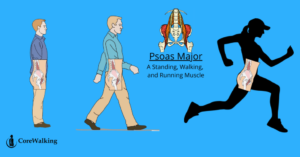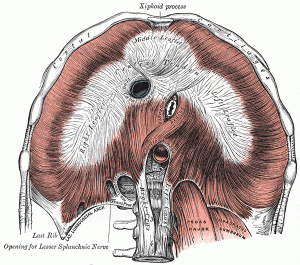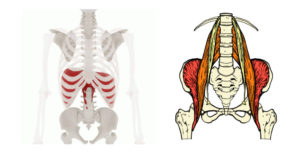The psoas is the walking muscle.

Walking and breathing are intimately connected through the psoas muscle and the diaphragm muscle.
The psoas major is the main muscle of walking, an action ideally initiated deep in the core of the trunk.
The psoas connects the spine to the legs. It attaches along the lower back (T12, L1-4) and at the back of the inner thigh.
Then it moves forward, across the pubic bone, and back again to attach to the back of the inner thigh.
The psoas muscle, if properly aligned is capable of supporting the spine and moving us through space.
When it is properly aligned, the psoas creates a downward pull on the front of the lower spine (lumbar vertebrae). This allows many muscles at the back of the body to lengthen up and tone.
This provides essential support for the head at the top of the spine.
When walking, the work of the two psoas muscles moving in opposition initiates the movement of the back leg forward.
This stimulates a natural and healthy rotation in the pelvis and throughout the spine.
Every step we take is meant to create a spinal twist.
Unfortunately, most people use their big thigh muscles (quadriceps) to walk them through life.
But if the body works according to design the psoas initiates movement, and many overworked muscles get to relax.
The Diaphragm is the breathing muscle.
 The diaphragm, a dome-shaped muscle at the base of the ribcage, is the essential muscle for breathing.
The diaphragm, a dome-shaped muscle at the base of the ribcage, is the essential muscle for breathing.
There are plenty of other muscles involved but the main muscle we want to use for respiration is the diaphragm.
When we inhale the diaphragm should descend allowing air to be drawn into the expanding lungs.
At the base of the pelvis three layers of muscle support the weight of the organs. These pelvic muscles– the levator ani– and the diaphragm work synergistically.
With each inhalation, the diaphragm and pelvic floor lower down at the same time. And with each exhalation, they rise back up.
This will also move the contents of the trunk between the pelvis and ribcage up and down.
Now we go back to the psoas and the spinal twist we can do with each well-executed step.
If all goes well we are combining the rotation created by the psoas and good walking, and the up and down movement when the diaphragm when we breathe well.
When this happens we are toning and massaging the entire contents of the trunk with each step and breath.
There are also connections between the psoas muscle and the diaphragm muscle that literally connect the acts of walking and breathing.
Walking and breathing: The Psoas and Diaphragm are connected.
 The psoas and diaphragm muscles have relatively literal connections to each other.
The psoas and diaphragm muscles have relatively literal connections to each other.
The diaphragm is a unique muscle that doesn’t attach like most muscles.
It has two tendons called the crura that extend down below the diaphragm. They connect to the spine right alongside the psoas attachments.
Another connection is through one of the ligaments of the diaphragm, the medial arcuate ligament. It wraps around the top of the psoas, and another muscle, the quadratus lumborum.
Finally, the diaphragm and the psoas connect through the fascia, the webbing that encases the body in both safe and sorry ways.
There is a particular fascial grouping that connects the diaphragm, psoas, and other hip muscles, including the quadratus lumborum.
There is a fairly specific design to the movement patterns of the body.
The relationship between these two titans of walking and breathing cannot be understated.
Health in one can and will encourage health in the other.
***
